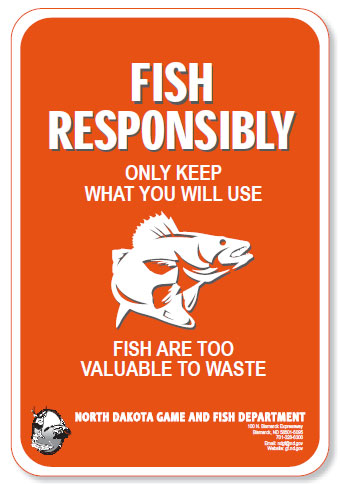
Fish Responsibly

Anglers will notice new signs at some of their favorite North Dakota fishing destinations this summer, reminding them of the valuable resources finning beneath the surface.
The message the signs impart is simple: “Fish Responsibly. Only Keep What You Will Use. Fish Are Too Valuable To Waste.”
Game and Fish personnel will bolt the orange-colored signs into place over the next couple of months at some of the state’s higher-use boat ramps on the Missouri River System, Devils Lake and elsewhere.
“The message is intended to get anglers to think about the value of our fisheries and natural resources that belong to everyone and are enjoyed by everyone,” said Greg Power, Game and Fish Department fisheries chief. “If the fishing is great all summer, do you really need to keep 50-100 walleyes when you are going to only use 20? We are trying to call to attention to the sometimes unknowing waste of fish.”

These northern pike were left to rot in the cattails. The Game and Fish Department urges anglers to keep only the fish they plan to eat, and to properly release all others back to the water.
This waste goes beyond freezer-burned filets that were stored too long. Reports from the public and staff have filtered in to Department headquarters about fish dumped in shoreline cattails and roadside ditches.
“If you put in the effort of buying a fishing license, loading your gear and wetting a line, you should have a plan in place when you catch fish,” Power said. “Anglers can’t set the hook first, then worry about what they are going to do with the fish later. We don’t want this valuable resource tossed in the weeds or freezer-burned.”
Scott Gangl, Department fisheries management section leader, said this mentality needs to be aimed at all fish, no matter the species.
“One step in getting people to think about all of this is by putting some value on the fish, be it a walleye, pike or catfish,” Gangl said. “It doesn’t matter what you catch because all fish have value.”
Fishing Deep
While tossing the day’s catch into the weeds is a deliberate and illegal waste of the resource, there are situations where some anglers are unwittingly killing fish they’ve caught and released.

Follow proper releasing procedures to ensure released fish will survive after they’ve been returned to the water.
While catch-and-release is often encouraged, it is only beneficial if the situation supports a safe return of fish to water. Gangl said fish caught in deep water – 25 feet and deeper – fall into that category where survival can be an issue, no matter the time of year.
We’ve reported before in this magazine about what fisheries biologists describe as barotrauma, or when a fish’s swim bladder balloons as it’s reeled up through the water column.
Devils Lake ice anglers commonly catch yellow perch in 30-45 feet of water, while walleye and sauger are pulled from similar depths in summer and fall on Lake Sakakawea.
“In Sakakawea, typically later in summer, walleye are targeting the cold water forage base (rainbow smelt), and anglers are catching these fish in 40-45 feet of water or deeper,” Gangl said.
The problem is that many fish caught from these depths likely don’t survive after they are released because of extreme changes in pressure on their journey to the net, causing swim bladders to expand. A fish under these circumstances can no longer control its balance in the water column.
“Also, extreme changes in pressure can cause eyeballs to pop out or blood vessels to burst and bleed,” Gangl said. “There are likely internal injuries not visible to anglers.”
Gangl said the message to anglers fishing in these situations is that they should plan to keep what they catch. And if anglers want to simply fish for recreation and have no interest in keeping anything for shore lunch, they should target fish in shallow water.
“We want anglers to understand the effects of catching fish from deep water,” Gangl said. “The key to catch-and-release fishing is that you need to release fish unharmed. This is often not the case from fish caught from those depths and then released.”
Catch-and-Release Tips
North Dakota Game and Fish Department fisheries biologists encourage catch-and-release fishing when the situation supports the safe return of fish to water. This practice of releasing fish the angler has no intention of using is effective only if fish are handled carefully. And anglers can do plenty to minimize harm to fish:
- Decide to release a fish as soon as it is landed. It is illegal in North Dakota to release a fish once it’s been in a livewell or on a stringer.
- Do not play fish longer than necessary.
- Bring fish up from deep water slowly so they can adjust to the pressure change.
- Have a tool – needle-nose pliers or a similar tool – at the ready to remove the hook.
- If the fish is hooked deep, cut leader or line close to the mouth. Don’t yank the hook from the gullet.
- If possible, leave the fish in the water when removing the hook.
- Use a landing net only when necessary.
- If the fish must be handled, use a wet glove or wet hand.
- Do not hold a fish by the eye sockets. This causes blindness or death.
- Avoid squeezing the fish to protect internal organs.
- Be careful not to damage the gills.
- Return fish to water quickly.
- When releasing an exhausted fish, gently cradle it in an upright position and move slowly back and forth in water until it fully recovers.
- If the fish is bleeding heavily, or if its swim bladder is protruding from the mouth, do not release it.
